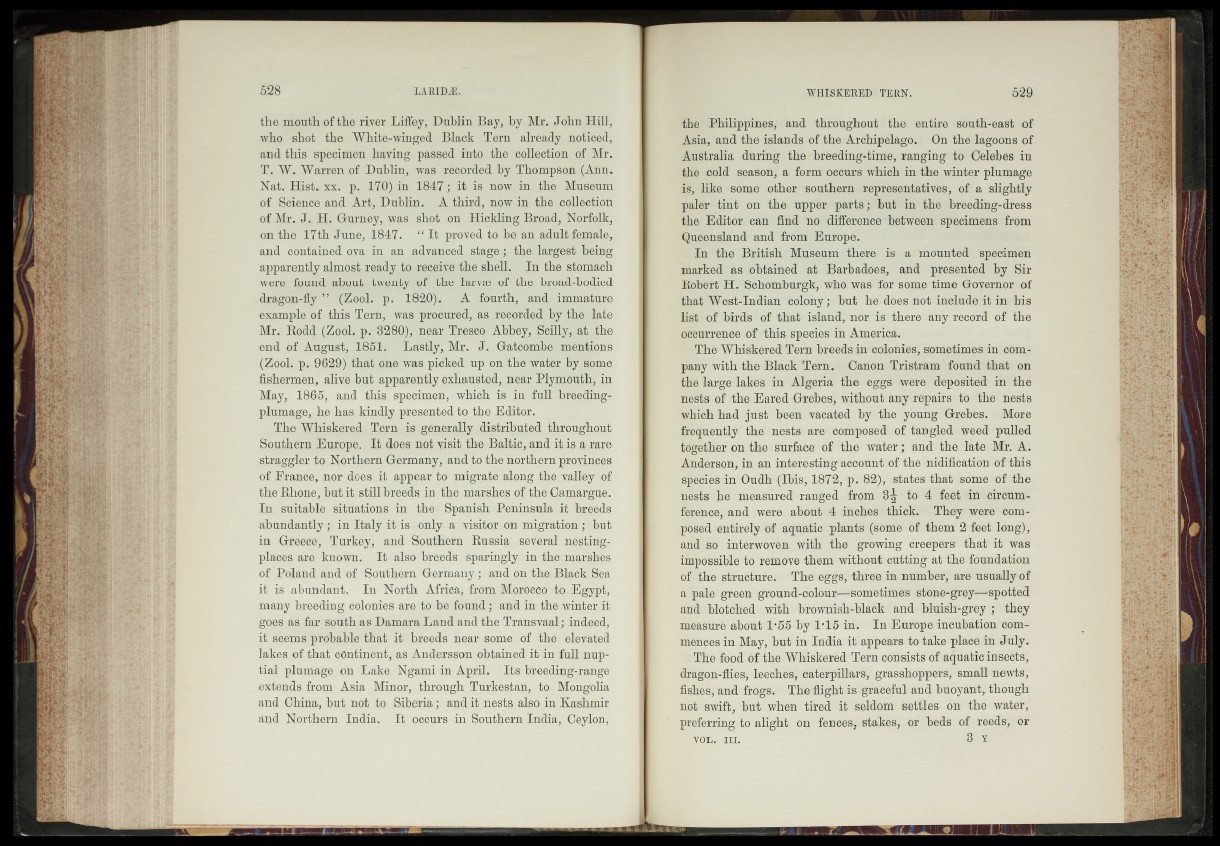
the mouth of the river Liffey, Dublin Bay, by Mr. John Hill,
who shot the "White-winged Black Tern already noticed,
and this specimen having passed into- the- collection' of Mr.
T. W. Warren of Dublin, was recorded by Thompson (Ann.
Nat. Hist. xx. p. 170) in 1847; it is now in the Museum
of Science and Art, Dublin. . A third, now in the collection
of Mr., J. H. Gurney, was shot on Hickling Broad, Norfolk,
on the 17th June, 1847. “ It proved to |tq; an adult female,
and contained ova in an advanced. stage; the largest being
apparently almost ready to receive the shell. :(Jnihe stomach
were found about twenty of the larvae of the- broad-bodied
dragon-fly ” (Zbbi. p. 1820)/ ' A fourth, and immature
example of this Tern, was procured, as recorded by the late
Mr. RodcL (Zool. p. 8280), near Tresco Abbey^ Scilly, at the
end of August, ,1851. Lastly, Mr. J. Gatcombe- mentions
(Zool. p. 9629) that'one was picked up on thé water by g|>me
fishermen, alive but apparently exhausted, near Plymouth, in
May, 1865, and this specimen, which is in fffl^hïeiding-
plumage, he has kindly presented, to the Editor.
The Whiskered Tpm is generally distributed throughout
Southern Europe. It does not visit the-Baltic, andd^is a rare
straggler to Northern Germany, andtóthe northern provinces
of France, -nor does it. appear to migratealong. the .valley (of
the Phone, but it still"breeds^S the marshes oJjt'heSCamargue.
In suitable Situations in the Spanish Peninsula .it brééds
abundantly ; in Italy-it is only a visitor on migration.; but
iffi Greece, Turkey;' and Southern Russia^ levêraï nesting-
plaees are known. It^sdso-J'breods'sparingly, in tbepmarshe.s
of Poland and of"Southern Germanyys and on the;BlackBea
it is abundant. In North Africa^ fxom:i(foh®'cco .to,-.-Egypt,
many breeding colonies-arecto be';fonnd.;_ and in the winter it
goes as far southas-Damara Land and the Transvaal-;, indeed,
it seeïhs’’probable that It'breeds near some "of? thé ^elevated
lakes |4f that cóntinent, as Andersson obtained it-in full nuptial
plumage-On Lake- Ngami in April. Its breeding.-ra-ige
extends -from Asia .Minor,: through Turkestan, l^gpgolia
and Ghina, hut not to Siberia; andifr nests also in Kashmir
and Northern^ Ipdia. It occurs in Southern India, C®ylon,
the Philippines> and throughout the entire south-east of
Asia, and the islands of the Archipelago. On the lagoons of
Australia during the breeding-time, ranging; ;to Celebes in
the -cold season^ a form occurs which in the winter plumage
is, like some other southern representatives, of a slightly
paler tin t . on the upper parts; but in the breeding-dress
the Editor can find no difference between'specimens from
Queensland and from ^Europe.
In f|the British Museum there is a-'-mounted specimen
marked as obtained at Barbadoes, and presented by Sir
Robert H. Schomburgk, who was for some time Governor; of
that West-Indian~ colony"; -/but he does mbt include!it in his
list of birds of that island, nor is ‘there any record of the
d>¥uirence of this specie^afa America.
iiiThe Whiskered Tern breeds in. colonies, sometimes in company
with the Black Tern. Canon Tristram found that:-on
the large lakes' in Algeria the eggs wereI deposited in the
neIts -o*f the; Eared Grebes; without any "repairs, to - the nests
which had gufet been ' vacated by the ybuirg Grebes; More
frequently: the' nests are composed, of tangled weed pulled
•together on the surface of ‘the water; and the late Mr. A.
Anderson, in an interesting account "of the nidificationb;f this
species in Oudh (Ibis,T8f§| p© 82)1,'.1 states that some of the
nests her measured ranged, tro in 8^ t-os 4 feet -in circumference,
and were about? 4 inches ^thick. They were composed
entirely «of aquatic plants (some of them 2’feet long),
and so interwoven with the growing creepers that if was
impossible to remove them without cuftingnt the foundation
of the structure.- The eggs,? three, in number, are usually of
a-pale green ground-Golaui;‘-^sbmetimfes stone-grey—spotted
anl.ifiot'ched with hrownish-blabkd and bluish-grey ; they
measure about 1*55 by 1*15 in-. In E ut ope, incubation commence
sin May; but-in Tmdia-it appears to take place-in July©
The food" of thetWhiskered Tern consists of .aquatic insects,
dragon-flies, leecheb|<eaterpillars, grasshopper^ small '-newts,
fishes; and frogs.. The.flightisigEacefuLand buoyant, though
not swift,‘but when tired; it seldom- kettles- on the- water^i
preferring to alight "on fencesy stakes, or beds of reeds,- 6r
jftybhl in. - 3 v